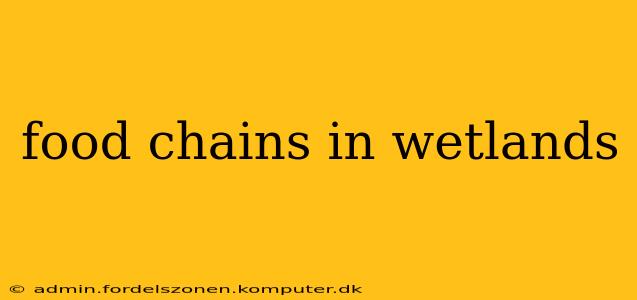Wetlands, those vibrant ecosystems where land meets water, support incredibly diverse and intricate food chains. Understanding these chains is crucial to appreciating the delicate balance of these vital habitats and the threats they face. This exploration delves into the fascinating world of wetland food webs, examining the key players and the interconnectedness that sustains them.
What are the different types of food chains in wetlands?
Wetland food chains aren't monolithic; they vary depending on the specific type of wetland (e.g., marshes, swamps, bogs) and its geographical location. However, we can broadly categorize them based on the primary producers:
-
Grazing Food Chains: These chains begin with plants like grasses, reeds, and aquatic vegetation. Herbivores, such as snails, insects, and waterfowl, consume these plants. These herbivores are then preyed upon by carnivores, including fish, amphibians, reptiles, birds, and mammals. Think of a simple chain: plant → snail → frog → snake.
-
Detritus Food Chains: These are arguably even more significant in wetlands. They start with dead organic matter (detritus), which includes decaying plants, animals, and other organic materials. Decomposers like bacteria and fungi break down this detritus, releasing nutrients back into the ecosystem. Detritivores, such as insects, crustaceans, and worms, feed on the decomposing matter. These are then consumed by larger predators, continuing the chain. A typical example: dead leaves → bacteria → insect larvae → fish.
-
Parasitic Food Chains: While less visually obvious, parasitic relationships play a vital role. Parasites, ranging from microscopic organisms to larger invertebrates, draw nutrients from their hosts, weakening them and sometimes leading to their death. This influences the populations of the host species and subsequently affects the entire food chain.
What are the main components of a wetland food chain?
Wetland food chains, like all food chains, consist of several key components:
-
Producers (Autotrophs): These are the base of the food chain, primarily plants that convert sunlight into energy through photosynthesis. Examples include cattails, sedges, algae, and phytoplankton.
-
Consumers (Heterotrophs): These organisms obtain energy by consuming other organisms. They can be further categorized into:
- Primary Consumers (Herbivores): These feed directly on producers. Examples include insects, snails, waterfowl, and some fish.
- Secondary Consumers (Carnivores): These feed on primary consumers. Examples include frogs, snakes, larger fish, and wading birds.
- Tertiary Consumers (Apex Predators): These are at the top of the food chain, preying on secondary consumers. Examples include large birds of prey, alligators, and some mammals.
-
Decomposers (Detritivores): These break down dead organic matter, returning essential nutrients to the ecosystem. Bacteria, fungi, and various invertebrates are key decomposers.
What are some examples of wetland food chains?
Let's illustrate with concrete examples:
-
Example 1 (Grazing): Algae → Daphnia (water flea) → Small fish → Larger fish → Heron
-
Example 2 (Detritus): Dead leaves → Bacteria and fungi → Insects → Frogs → Snakes
-
Example 3 (Combined): Aquatic plants → Snails → Dragonflies → Frogs → Herons
How do food webs differ from food chains in wetlands?
While a food chain illustrates a linear sequence of energy transfer, a food web is a more realistic representation of wetland ecosystems. Food webs show the complex interconnectedness of multiple food chains, with organisms often occupying multiple trophic levels (feeding positions). For example, a single fish might eat both insects (primary consumer) and smaller fish (secondary consumer), making it part of multiple chains within the larger web.
How do humans impact wetland food chains?
Human activities significantly impact wetland food chains, often with detrimental effects. Pollution (e.g., pesticides, fertilizers) can bioaccumulate in organisms, harming or killing them. Habitat destruction and alteration through drainage, development, and invasive species introduction disrupt the delicate balance of the food web, causing population declines and even extinctions. Climate change also plays a crucial role, altering water levels and temperatures, affecting the distribution and abundance of species, and potentially disrupting the entire food web.
What is the importance of wetland food chains?
Wetland food chains are fundamental to the health and function of these ecosystems. They regulate nutrient cycling, maintain biodiversity, and support a wealth of plant and animal life. The intricate interactions within these chains ensure the sustainability of wetlands, providing essential ecosystem services such as water purification, flood control, and carbon sequestration. Understanding and protecting these chains is crucial for preserving the invaluable ecological services wetlands provide.
